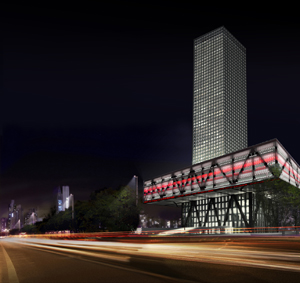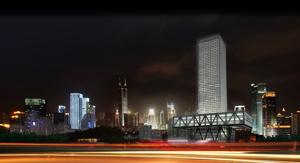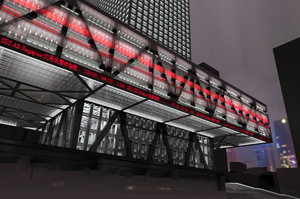 |
 |
 |
 |
 |
 |
| |
 |
|
 |
 |
 |
  |
  |
 |
 |
 |
 |
|
|
 |
|
 |
 |
 |
BUILDING |
 |
|
 |
|
 |
 |
 |
| |
 |
| 
 |
Shenzhen Stock Exchange
|
|
 |
 |
 |
 |
DESIGNER |
 |
|
|
 |
|
 |
 |
 |
| |
 |
|
 |
 |
 |
 |
DESCRIPTION |
 |
|
|
 |
|
 |
 |
 |
|
|
 |
 For millennia, the solid building stands on a solid base; it is an image that has survived modernity. Typically, the base anchors a structure and connects it emphatically to the ground. The essence of the stock market is speculation: it is based on capital, not gravity. In the case of Shenzhen's almost virtual stock market, the role of symbolism exceeds that of the program – it is a building that has to represent the stock market, more than physically accommodate it. It is not a trading arena with offices, but an office with virtual organs that suggest and illustrate the process of the market. For millennia, the solid building stands on a solid base; it is an image that has survived modernity. Typically, the base anchors a structure and connects it emphatically to the ground. The essence of the stock market is speculation: it is based on capital, not gravity. In the case of Shenzhen's almost virtual stock market, the role of symbolism exceeds that of the program – it is a building that has to represent the stock market, more than physically accommodate it. It is not a trading arena with offices, but an office with virtual organs that suggest and illustrate the process of the market.
All of these factors suggest an architectural invention: our project is a building with a floating base. As if it is lifted by the same speculative euphoria that drives the market, the former base has crept up the tower to become a raised podium. Lifting the base in the air vastly increases its exposure; in its elevated position, it can 'broadcast' the activities of the stock market to the entire city. The space liberated on the ground can be used as a covered urban plaza, large enough to accommodate public events. The Shenzhen Stock Exchange – which will rise to 248m – is planned as a financial centre with civic meaning, located in a new public square at the meeting point of the north-south axis between Mount Lianhua and Binhe Boulevard, and the east-west axis of Shennan Road, Shenzhen's main artery.
The raised base of the SSE is a three-storey cantilevering podium floating 36m above the ground, with a floor area of 48,000m2 and an enormous roof garden. The podium and lower tower contain the dedicated stock exchange functions, with the stock exchange offices, registration, technical center, and clearing house. At the base, the tower is flanked by two atria – voids connecting the ground directly with the trading floor. Staff enter the building from the west and public enter from the east.
The generic square form of the tower obediently follows the form of surrounding homogenous towers, but the façade of the SSE building is unique. The tower's structure is a robust exoskeletal grid wrapped with a patterned glass skin – the first time such glass has been used for an exterior at this scale. The patterned glass renders the detail and complexity of construction mysterious while creating depth as the tower responds to light: crystalline in bright sunshine, mute on an overcast day, enigmatic at dusk, glimmering during rain showers and glowing at night. |
|
 |
 |
 |
|
 |
|
|
|
 |
 How does this building re-envision the project of the skyscraper? How does this building re-envision the project of the skyscraper?
At just under 250m tall, the building is hardly a skyscraper. Its 168m by 100m elevated podium is however an additional 18 floors (one third its total height) ‘covertly’ suspended horizontally. The design attempts to consolidate all the public and stock exchange programs not at the peak of the tower, the perhaps more conventional location, but into a dense, elevated platform. The platform broadcasts the energy and activities of the stock market to the public, while liberating the ground plane for their formal, social and political convergence.
 What is needed, architecturally, for a stock exchange building? What is needed, architecturally, for a stock exchange building?
The identity of traditional stock exchange building was characterized by incredible energy of the trading floor. In today’s age of the electronic stock market, the traditional trading floor has become extinct, and along with it, the identity of the stock market. One of the main architectural challenges of this building was the recreation of this energetic identity in today’s stock market.
Would this sort of building be possible in other parts of the world? Is the project somehow distinctly ‘Chinese’?
It would be conceited to believe that this building would not be possible in any other part of the world today; particularly in view of the increasing client ambitions we constantly encounter in regions like the Middle East. However, a collection of subtle yet significant design peculiarities make this project distinctively local.
Any innovations of note here in the construction, design, or OMA process in general?
The project’s innovative and extensive use of pattern glass will be a significant breakthrough for the Chinese high rise tower and a notable triumph of engineering. We were able to accomplish this terrific feat by harnessing the world’s largest glass manufacturing industries and by closely collaborating with local experts.
What are the main materials? When was groundbreaking and when will the building be completed?
Concrete, steel and glass. The ground breaking occurred in November 2007 and the completion is scheduled for the end of 2010.
Edit by OMA |
|
 |
 |
 |
 |
 |
 |
 |
MATERIALS |
 |
|
|
 |
|
 |
 |
 |
 |
 |
|
 |
 |
 |
 |
LOCATION |
 |
|
|
 |
|
 |
 |
 |

|
 |

|
Continent |
|
 |
  Asia |
|
Nation |
|
 |
  China [Zhōngguó/Zhōnghuá] |
|
Province |
|
 |
  Guangdong |
|
Town |
|
 |
  Shenzhen |
|
District |
|
 |
  Futian |
|
Address |
|
 |
  Binhe Boulevard, Shennan Road
|
|
|
|
 |
|
 |
 |
 |
 |
MAP |
 |
|
|
 |
|
 |
 |
 |
| |
 |
|
 |
 |
 |
 |
|
TYPOLOGY |
 |
|
|
 |
|
 |
 |
 |
Main |
 |
|
 |
ARCHITECTURE | Commercial buildings
Banks, securities exchanges and buildings for financial activity
Vertical architectures
Skyscrapers
| |
|
|
 |
|
Additional |
 |
|
 |
ARCHITECTURE | Buildings for offices and professional practises
Offices
| |
 |
 |
 |
 |
CHRONOLOGY |
 |
|
|
 |
|
 |
 |
 |
Project |
 |
|
 |
| 
 |
2006
project winner of competition
|
|
Realisation |
 |
|
 |
| 
 |
2007 - 2011 |
|
 |
 |
 |
 |
CLIENT |
 |
|
|
 |
|
 |
 |
 |
| |
 |
|
 |
 |
 |
 |
DIMENSIONAL
DATA |
 |
|
|
 |
|
 |
 |
 |
| Surface |
 |
|
 |
floor sq.m. 200,000
site sq.m. 132,000 |
|
| Height |
 |
|
 |
|
| Floors |
 |
|
 |
|
 |
 |
 |
 |
STRUCTURES |
 |
|
|
 |
|
 |
 |
 |
| |
 |
|
 |
 |
 |
 |
LANDSCAPE DESIGN |
 |
|
|
 |
|
 |
 |
 |
| |
 |
Inside Outside
Petra Blaise, Rosetta Elkin, Aura Melis |
|
 |
 |
 |
 |
STAFF |
 |
|
|
 |
|
 |
 |
 |
|
 |
|
Project architect |
 |
| Rem Koolhaas, Ellen van Loon |
|
Construction management |
 |
|
Project leader |
 |
|
Associate architect |
 |
|
Design team |
 |
Building:
Yang Yang, Vincent Kersten, Daan Ooievaar, Yun Zhang, Ryann Aoukar, Sebastian Appl, Waichuen Chan, Jan Dechow, Leo Ferretto, Clarisa Garcia Fresco, Alasdair Graham, Leonie Wenz, Richard Sharam, Laura Baird, Matthew Jull, Franscesca Portesine, Lukasz Skalec, Lukasz Szlachcic, Lukas Drasnar, Christine Svensson, Matthew Haseltine, Jaitian Gu, João Ferreira Marques Jesus, Alex de Jong, Santiago Hierro Kennedy, Klaas Kresse, Miranda Lee, Anna Little, Luxiang Liu, David Eugin Moon, Cristina Murphy, Idrees Rasouli, Korbinian Schneider, Wolfgang Schwarzwalder, Felix Schwimmer, Michela Tonus, Miroslav Vavrina, Ferdjan Van der Pijl, Se Yoon Park, Na Wei, Xinyuan Wang, Ken Yang Tan, Su Xia, Yunchao Xu
Project:
Rotterdam
Rem Koolhaas, Shohei Shigematsu, Anna Little, Christin Svensson, Jason Long, Carlos Garcia Gonzalez, Joao Bravo da Costa, Mauro Paraviccini, Mariano Sagasta, Bart Schoonderbeek, Konstantin August, Klaas Kresse, Kengo Skorick, Katharina Gerlach, Mendel Robbers, Hong Yong Sook, Beatriz MInguez de Molina, Martti Kalliala, Andrea Bertassi, Daniel Ostrowski, Yuanzhen Ou
AMO
Todd Reisz, Brendan McGetrick
Beijing
Ole Scheeren, Dongmei Yao, Hiromasa Shirai, Anu Leinonen, Tieying Fang, Pei Feng, Xinyuan Wang |
|
Gestione del progetto |
 |
Arup
Nancy Huang, Wei Gao, Penny Liu, Jerry Zhang |
|
Structural consultant |
 |
Arup
Chas Pope, Goman Ho, Xiaonian Duan, Chris Carroll, Robin Ching, Guo-Yi Cui, Andrew Grant, Yue Hao, Jonathan Kerry, Di Liu, Peng Liu, Hui-yuan Long, Alex To, Fei Tong, Matthew Tsang, Yu-Bai Zhong, FX Xie, Liang Xu, Ling Zhou, Façade Engineering - Gerald Hobday, Andy Lee. |
|
Acoustical consultant |
 |
DHV Building and Industry
Bertie van de Braak, Caroline Kaas, Renz van Luxemburg, Theo Rijmakers |
|
Lighting design |
 |
Arup
Steve Walker, Francesco Anselmo, Katie Hardstone, David Lakin, Florence Lam |
|
Vertical transportation |
 |
Arup
Matthew Tang, Julian Olley |
|
Physical engineering |
 |
Arup
Vincent Cheng, Isaac Tang, Raymond Yau, Rumin Yin |
|
Geotechnical |
 |
Arup
Mark Choi, Maggie Qing-Min Meng, Jason Ng, Wei-Guang Ruan |
|
Computerization |
 |
Arup
Patrick Leung, Michael Tomordy, Sam Tsoi, Henry Chan, Mark Chen, Jacky Lo , Wing-Shan Mak, Edwin Wong |
|
Quantity surveyor |
 |
L&B Quantity Surveyors
Law Hing Wai, Melody Huang |
|
 |
  |
 |
|
|